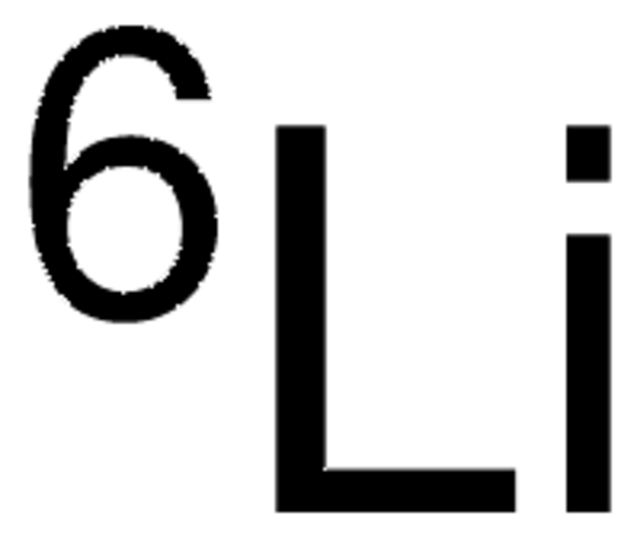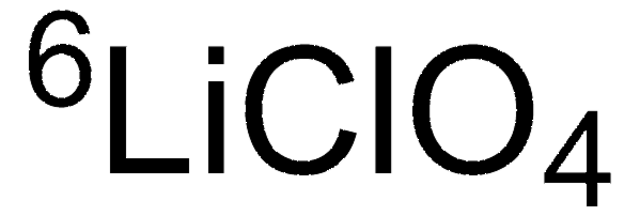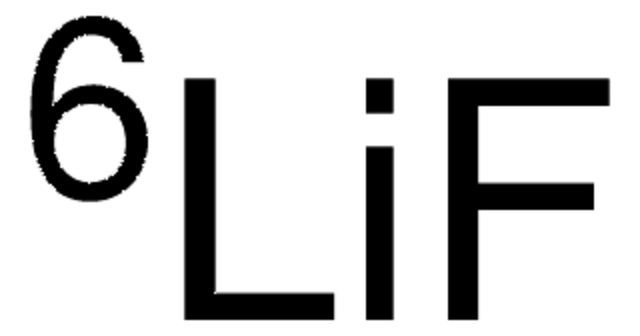Wszystkie zdjęcia(1)
Kluczowe dokumenty
601535
Lithium-7Li
≥99.8 atom % 7Li, ≥99.8% (CP)
Zaloguj sięWyświetlanie cen organizacyjnych i kontraktowych
About This Item
Wzór empiryczny (zapis Hilla):
7Li
Numer CAS:
Masa cząsteczkowa:
7.02
Kod UNSPSC:
12141803
Identyfikator substancji w PubChem:
Polecane produkty
czystość izotopowa
≥99.8 atom % 7Li
Próba
≥99.8% (CP)
Formularz
solid
przesunięcie masy
depleted
ciąg SMILES
[7Li]
InChI
1S/Li
Klucz InChI
WHXSMMKQMYFTQS-UHFFFAOYSA-N
Powiązane kategorie
Opakowanie
This product may be available from bulk stock and can be packaged on demand. For information on pricing, availability and packaging, please contact Stable Isotopes Customer Service.
Ta strona może zawierać tekst przetłumaczony maszynowo.
Hasło ostrzegawcze
Danger
Zwroty wskazujące rodzaj zagrożenia
Zwroty wskazujące środki ostrożności
Klasyfikacja zagrożeń
Skin Corr. 1B - Water-react 1
Zagrożenia dodatkowe
Kod klasy składowania
4.3 - Hazardous materials which set free flammable gases upon contact with water
Klasa zagrożenia wodnego (WGK)
WGK 1
Temperatura zapłonu (°F)
Not applicable
Temperatura zapłonu (°C)
Not applicable
Wybierz jedną z najnowszych wersji:
Masz już ten produkt?
Dokumenty związane z niedawno zakupionymi produktami zostały zamieszczone w Bibliotece dokumentów.
Mohamed Aklalouch et al.
ChemSusChem, 8(20), 3465-3471 (2015-09-19)
By comparing carbon electrodes with varying porosity in Li-O2 cells, we show that the effect of electrolyte stirring at a given current density can result in a change from 2D to 3D growth of discharged deposits. The change of morphology
Xiao Tang et al.
Scientific reports, 5, 11958-11958 (2015-07-08)
LiNi0.5Mn1.5O4 nanorods wrapped with graphene nanosheets have been prepared and investigated as high energy and high power cathode material for lithium-ion batteries. The structural characterization by X-ray diffraction, Raman spectroscopy, and Fourier transform infrared spectroscopy indicates the LiNi0.5Mn1.5O4 nanorods prepared
Emanuel Peled et al.
Nano letters, 15(6), 3907-3916 (2015-05-15)
Here, we report on the scalable synthesis and characterization of novel architecture three-dimensional (3D) high-capacity amorphous silicon nanowires (SiNWs)-based anodes with focus on studying their electrochemical degradation mechanisms. We achieved an unprecedented combination of remarkable performance characteristics, high loadings of
Birte Jache et al.
Angewandte Chemie (International ed. in English), 53(38), 10169-10173 (2014-07-25)
Although being the standard anode material in lithium-ion batteries (LIBs), graphite so far is considered to fail application in sodium-ion batteries (NIBs) because the Na-C system lacks suitable binary intercalation compounds. Here we show that this limitation can be circumvented
M Helen et al.
Scientific reports, 5, 12146-12146 (2015-07-16)
Lithium-sulphur batteries have generated tremendous research interest due to their high theoretical energy density and potential cost-effectiveness. The commercial realization of Li-S batteries is still hampered by reduced cycle life associated with the formation of electrolyte soluble higher-order polysulphide (Li2Sx
Nasz zespół naukowców ma doświadczenie we wszystkich obszarach badań, w tym w naukach przyrodniczych, materiałoznawstwie, syntezie chemicznej, chromatografii, analityce i wielu innych dziedzinach.
Skontaktuj się z zespołem ds. pomocy technicznej









